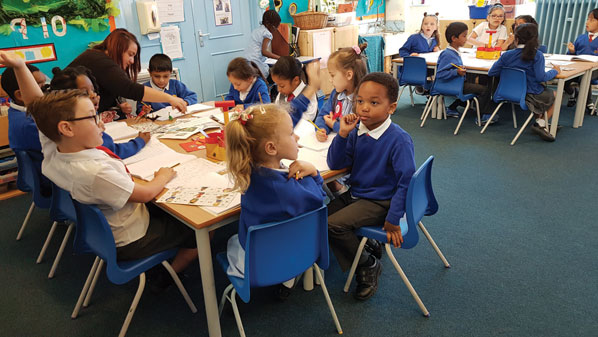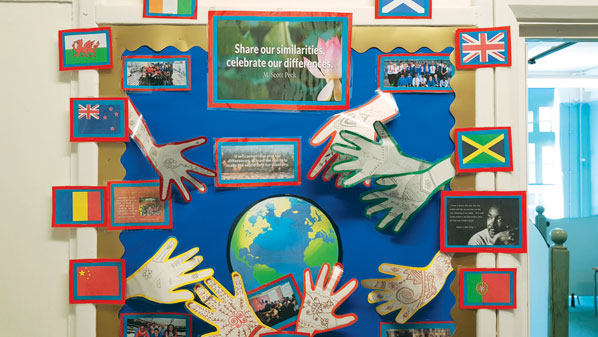Tollgate school visit
Tollgate Primary School in Plaistow, East London, has a reputation for being an inclusive school. Richard Rieser and Yvonne Brouwers visited to see how this works in practice. For Yvonne, who lives locally, this was an interesting opportunity to write about an inclusive school in her own community.

Tollgate is a lively primary school with about 450 pupils and 14 classrooms. The site was quite restricted as they are currently building an extension to the 1930s building with a direct government grant to extend access. When completed this Autumn the whole campus will be wheelchair accessible with a lift. There is currently a long waiting list. Despite the ongoing building and crowds, we noticed no overly loud shouting or chaotic running. Katie told us that this is an explicit focus of the Headteacher and the result is a calm and peaceful school environment in which all pupils can feel safe and comfortable.
There is a separate “Family Centre” where parents and families are welcome to do different activities, like a coffee morning for parents of children with SEN. We met Vicky George, one of the family workers at the school. Her two older children are at the school and her 3 year old with ASC has started in the nursery. ”When he started he had no language. Already he has 15-20 words and signs. Putting my child here it’s like a family. Very inclusive and every parent is helped from the beginning.”
Tollgate is a resourced school, with a specialism for children identified with Autistic Spectrum Condition (ASC). The school has 14 resourced places for children with ASC but there are twice as many children with ASC attending. There are a further 25 disabled children, including children with hearing and visual impairment, dyslexia, ADHD and global development delay. Altogether there are 54 disabled pupils, about 12% of the school’s population. They are proud to be the first mainstream school to have gained accreditation from the National Autistic Society.
The nursery has 40 morning and 40 afternoon children. Nursery, Reception to Year 6 and children with ASC are allocated to every class with a key worker. The school and its provision are rated by OFSTED as Outstanding.
Tollgate believes all children have the right to access the same opportunities as their peers and benefit from the modelling that takes place in a mainstream setting. All disabled children are therefore part of their mainstream classes and access the national curriculum, whilst their Individual Education Plan (IEP) addresses their specific areas of difference.
The school is a recognised Initial Teacher Training Centre. The advantage of this teacher training approach is the focus on inclusion, with five days of the taught course and placements in inclusive classes. With more than 40 schools in the Alliance, a job is guaranteed to all completing the course.
We were shown round by Katie Pugh, Assistant Headteacher for Inclusion and Sarah Emir, a Learning Support Teacher. They told us every child was allocated to a class and the aim was for them to spend as much time as possible in the classroom with their own personalised targets, supported by assistants. They have three fulltime learning resource teachers, 26 learning support assistants, two speech and language therapists (one full time equivalent) and three behaviour mentors. Having a full time SALT greatly benefits the development of the children’s language and literacy.
Katie explained that pupils are only taken out of the classroom when the child themselves is distressed and needs some time in a quieter space. Children with SEND spend from 100% to 20/30% of their time in the mainstream classroom.
Katie and Sarah explained the structure of support for the children with autism. The three learning support teachers lead three teams covering Lower (Reception to Year 2) Middle (Year 3 & 4) and Top (Year 5 & 6), monitor their progress and develop Individual Education Plans with three meetings a year with parents. The school does not use any one approach to ASC. Each child has an individual timetable depending on how much time they can manage in their mainstream class. Visual timetables are used for all children with ASC. There are five spaces for withdrawal, small group work, one-to-one or chillout and for a wide range of interventions including messy play, speech and language, PECs, Proloquo2Go, Signalong, Colourful Semantics, Intensive Interaction, Attention Autism, Music Interaction, Sensory Integration, Life Skills and Lego Therapy. This last was particularly popular, with mixed groups taking different roles to collectively build the model. Each of the children has their own task according to their ability and the children also form friendships this way.
The children who are non-verbal learn Signalong (a system of signs derived from British Sign Language) with a new sign to learn every week. I (Yvonne) was especially happy to see this emphasis on teaching signs to all the children as my own daughter uses Signalong to communicate and always has to teach other people signs before they can interact well with her. I feel that the whole community will benefit when the non-disabled children learn signing so they are equipped to communicate with everyone. Signalong have recently developed a syllabus and accredited courses for schools. Perhaps this would be a good opportunity for the whole school to make Signalong a more serious part of the curriculum.
The Green room, where children with ASC can go with a key worker, is a quiet space with stalls that cut out sensory overload. Next door is the Yellow room with tables for small group work, cooking facilities and a place where the class sessions can be broken up with snack time for children with ASC who need it. There is a sensory room and, until the building works, a soft play room. We were also shown a hall with space for mini-trampolines, mats and blocks where physiotherapy and sensory integration therapies take place.

In every classroom we spotted one or more children supported by teaching assistants, sitting between their peers or alone at a table when that made them feel more comfortable.
We asked how the non-disabled children get on with those with impairments. The Learning Support Teachers felt that because they have all been in the same class since reception the children accepted and got on well with each other. They had assemblies and PSHE lessons on disability and the whole school engages in activities on World Autism Day. All children are together at registration, assembly, lunch and playtime; we thought there was an opportunity for more formal circles of friends and buddying, which would enrich the offer at the school.
There is a buddy system in the playground and Katie says that the pupils who have a disabled sibling are more understanding of disability, make friends more easily with disabled pupils and are their best advocates.
We asked what role the class teacher takes and were told they were responsible for the learning of all children in their class and planned and differentiated the work so it was appropriate for each child. There is staff training every Monday and Katie Pugh has at least a session every half term. The Teaching Assistants all complete the five day ACS training at the Tunmarsh centre with certification. The school has access to a specialist advisory teacher in the Borough’s Language Communication and Interaction Service.
We noted lots of effective teaching and innovative inclusive practice. Staff could not remember the last exclusion. Katie told us proudly about a boy on the autistic spectrum who came to the school non-verbal and on the P levels and now in year six he has progressed so much that he is doing SATS.
Our impression of the school was that it was quiet, well ordered and work in every class was purposeful. The school was full of colourful displays of beautifully made art and craft work. And in the art gallery there was wonderful art by the pupils with higher educational support needs presented amongst all the other artwork. All children take part in school and class performances.
It is expected all children go on out of school trips, which are tested beforehand for accessibility, though sometimes adjustments are made such as only going for the day on residential trips. There are many after school and holiday clubs, but we learnt that unfortunately transport often hinders participation. The only disabled students currently included in after school clubs are the ones whose parents can take them and pick them up.
What were the outcomes for the children with ASC? The school used the p-scales and National Curriculum Levels for the 14 Resource Base pupils to measure academic progress. The progress shown in all but two pupils was expected or above, with which Ofsted were more than satisfied.
Headteacher Tom Canning told us that his passion for inclusion came from his experience at university in the eighties, where he came across a disabled person for the first time and noticed he was afraid because he had never seen a disabled person before and didn’t know how to engage with them. He thought how wrong this was and that disabled people should have the opportunity to go to mainstream schools all the way, just like himself. He says he has been passionate about social justice ever since. Therefore the motto of his school is All Children Are Welcome. They do not reject any disabled children.
The schools in this trust are academies and they are all inclusive, which shows that being an academy is not necessarily bad for inclusion as long as the attitude of the leadership is inclusive. Tom explained that it is an advantage to be an academy, a school led system, as opposed to a local authority (LA) led system, because there is so much instability at the local authority. We could see how it could be empowering in this world with its resistance against inclusion to be one of seven in a trust of like-minded schools.
As we left we were impressed and wondered if Tollgate and the Boleyn Trust were the exceptions that showed inclusion can work in academies if the will is there. Sadly in far too many it is not.
We are grateful to Tom and Katie for all the time they spent with us and to all staff and children who gave us a look in their daily lessons and activities. When we said goodbye Tom surprised Yvonne by saying that, for years, he had enjoyed seeing her and her daughter Sterre cycle past on the tandem to and from Sterre’s secondary school and seeing her growing up. This made her feel that he was really interested in inclusion in the wider community, not just within his school.
![Allfie [logo]](https://www.allfie.org.uk/wp-content/themes/allfie-base-theme/assets/img/allfie-logo-original.svg)



